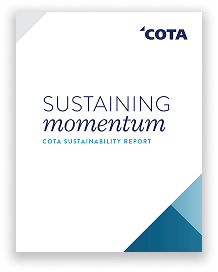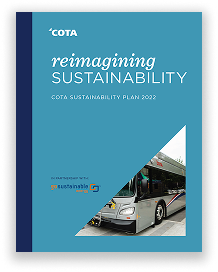ENVIRONMENTAL PROMISE
Leading the Way to a Greener Future
At COTA, we’re committed to reducing our environmental impact and leading the way toward a more connected future. Our comprehensive environmental strategy encompasses various initiatives aimed at minimizing emissions, conserving resources and promoting innovative practices. Here’s how we’re making a difference:
Diesel-Free Fleet by 2025
By 2025, we’re phasing out diesel-powered buses from our fixed-route fleet, transitioning to cleaner alternatives. This initiative represents a significant step forward in improving air quality across Central Ohio.
Net-Zero Greenhouse Gas Emissions by 2045
We’re dedicated to achieving net-zero greenhouse gas emissions by 2045, aligning with Columbus’ efforts to combat climate change. Through ongoing innovation and strategic investments, we’re working tirelessly to create a cleaner, healthier environment for future generations.
Investing in NEW Technologies
From 5G-enabled Wi-Fi on our vehicles to the expansion of our compressed natural gas (CNG) fleet, we’re continuously striving to enhance efficiency, reduce emissions and improve the overall transit experience for our passengers.
Environmental Stewardship in Action
Beyond our fleet and operations, we’re implementing environmentally conscious practices throughout our organization. This includes rainwater harvesting for vehicle washing, LEED-certified facilities with energy-efficient features and comprehensive recycling programs that minimize waste and conserve resources.
Community Engagement and Collaboration
We recognize that achieving our goals requires collective action and collaboration. That’s why we actively participate in initiatives like SWACO’s Roundtable, Clean Fuels Ohio and MORPC’s Energy and Environment Committees, working alongside community partners to innovate regionally.
Our Commitment in Numbers
diesel-free
fixed-route fleet by 2025
net-zero
greenhouse gas emissions by 2045
7.9 TONS
of cardboard recycled annually
75.9 TONS
of scrap metal recycled annually
3.2m gallons
of water saved per year through conservation efforts
Together, we can create a more prosperous future for Central Ohio and beyond.
Join us in our journey, and together, we’ll make a positive impact on our planet and communities.
Let’s ride toward a brighter tomorrow.

